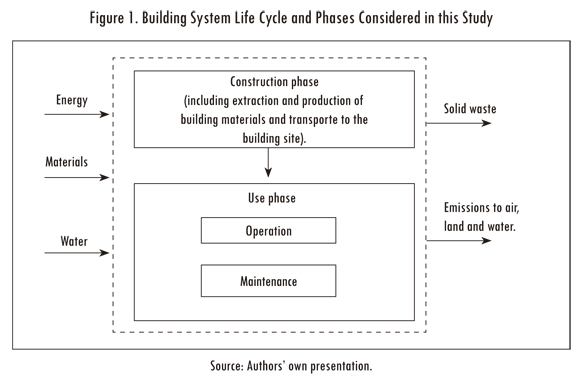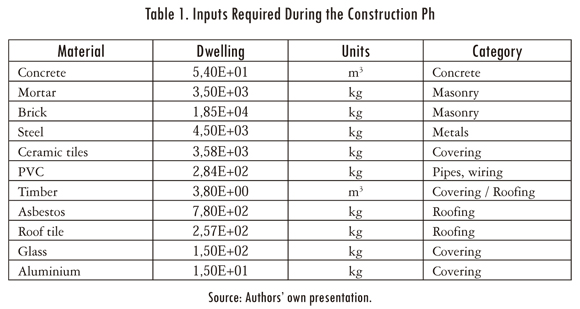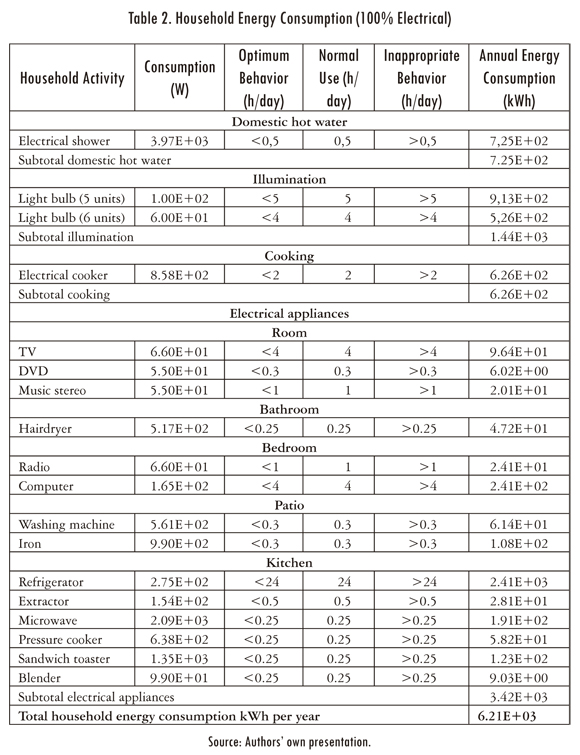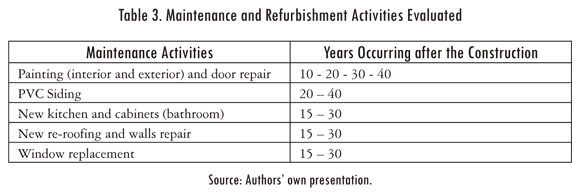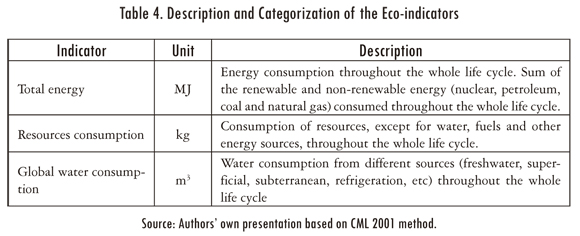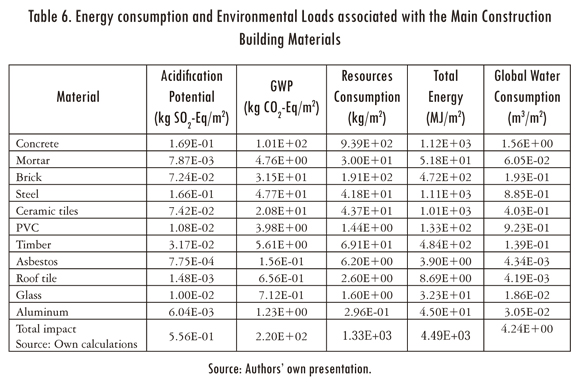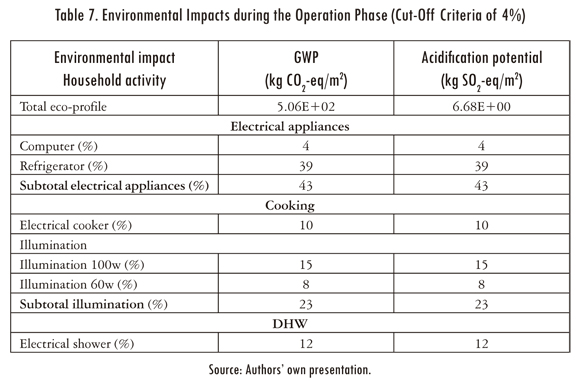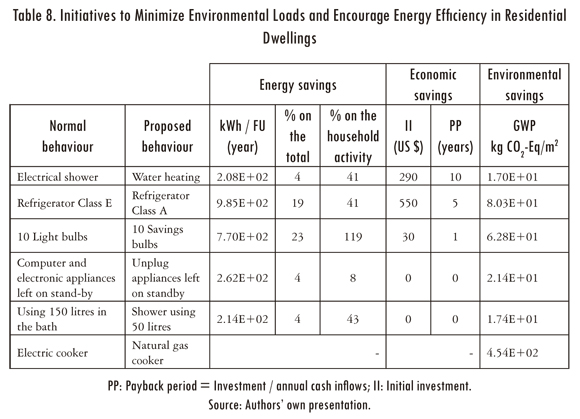Services on Demand
Journal
Article
Indicators
-
 Cited by SciELO
Cited by SciELO -
 Access statistics
Access statistics
Related links
-
 Cited by Google
Cited by Google -
 Similars in
SciELO
Similars in
SciELO -
 Similars in Google
Similars in Google
Share
Ingeniería y Universidad
Print version ISSN 0123-2126
Ing. Univ. vol.16 no.1 Bogotá Jan./June 2012
Environmental Impact of the Construction and Use of a House: Assessment of Building Materials and Electricity End-Uses in a Residential Area of the Province of Norte de Santander, Colombia1
Impacto Ambiental de la construcción y uso de una casa: Estudio de los materiales de construcción y el consumo final de energía eléctrica en un área residencial del departamento de Norte de Santander, Colombia2
Impacto Ambiental da construção e uso de uma moradia: Estudo dos materiais de construção e consumo final de energia elétrica num área residencial do departamento de Norte de Santander, Colômbia3
Óscar Ortiz-Rodríguez4
Francese Castells5
Guido Sonnemann6
1This article is the result of the research project Sustainability Assessment within the Residential Building Sector: A Practical Life Cycle Method Applied in a Developed and a Developing Country. Developed by the Universidad de Pamplona, Colombia and Universitat Rovira I Virgili, Spain.
2Fecha de recepción: 6 de diciembre de 2010. Fecha de aceptación: 9 de agosto de 2011. Este artículo se deriva de un proyecto de investigación denominado Sustainability Assessment within the Residential Building Sector: A practical Life Cycle Method applied in a developed and a developing Country, desarrollado por la Universidad de Pamplona, Colombia, y la Universitat Rovira I Virgili, España.
3Data de recepção: 6 de dezembro de 2010. Data de aceitação: 9 de agosto de 2011. Este artigo deriva de um projeto de pesquisa denominado Sustainability Assessment within the Residential Building Sector: A Practical Life Cycle Method applied in a developed and a developing Country, desenvolvido pela Universidade de Pamplona, Colômbia, e a Universitat Rovira I Virgili, Espanha.
4Industrial Engineer, Universidad Libre, Cúcuta, Colombia. Master in Engineering Management, Queensland University of Technology, Brisbane, Australia. PhD in Chemical, Environmental and Process Engineering, Universidad Rovira I Virgili University, Tarragona, Spain. Associate Professor, Universidad de Pamplona, Pamplona, Colombia. E-mail: oscarortiz@unipamplona.edu.co.
5Chemical Engineer, Institut Químic de Sarria, Barcelona, Spain. Master in Chemistry, Universitat de Barcelona, Spain. PhD, Institut du Génie Chimique de Toulouse, France. Professor, Universidad Rovira i Virgili, Tarragona, Spain. E-mail: francesecastells@urv.cat.
6Environmental Engineer, Technical University of Berlin, Germany. Master in Water Treatment, Higher Engineering School of Poitiers, France. PhD in Environmental Management and Engineering, Universidad Rovira i Virgili University, Tarragona, Spain. Research Fellow of the Environmental Management and Engineering (AGA) Group, Universidad Rovira i Virgili. Tarragona, Spain. E-mail: Guido.Sonnemann@unep.org.
Submitted on December 6, 2010. Accepted on August 9, 2011.
Abstract
The objective of this research is to assess the environmental impacts associated with the construction and use of a residential house. Building materials and electricity end-uses were assessed. The study was used to highlight some initiatives for the residential-building industrial sector and also some of the aspects that should be considered when trying to improve sustainability indicators. As a study case, a Colombian dwelling located in the city of Pamplona was chosen. The findings of this research showed that the highest environmental impacts during the dwelling's life cycle take place during the operation phase of the dwelling, while construction phase generates about 7-28% of the impact. Transportation and maintenance combined account for less than 10% of the life cycle impacts.
Keywords: Sustainable development, environmental impact analysis, architecture.
Resumen
El objetivo de la investigación es evaluar el impacto ambiental de la fase construcción y uso de una casa localizada en un área residencial. Los materiales de construcción y usos finales de electricidad fueron evaluados. El estudio se uso para dar algunas iniciativas al sector de la construcción residencial que deben tenerse en cuenta a la hora de tratar de mejorar los indicadores de sostenibilidad. Como caso de estudio se escogió una vivienda colombiana localizada en la ciudad de Pamplona. Los resultados de esta investigación muestran que el mayor impacto ambiental durante el ciclo de vida de la vivienda tiene lugar durante la fase de operación de la vivienda, mientras que la fase de construcción genera aproximadamente 7%-28% del impacto. El transporte y el mantenimiento representan menos del 10% de los impactos.
Palabras clave: Desarrollo sostenible, evaluación del impacto ambiental, arquitectura doméstica.
Resumo
O objetivo da pesquisa é avaliar o impacto ambiental da fase construção e uso de uma moradia localizada num área residencial. Os materiais e usos finais foram avaliados. O estudo foi utilizado para dar iniciativas ao setor da construção residencial a levar em conta na hora de melhorar indicadores de sustentabilidade. Como um caso de estudo foi escolhida uma moradia colombiana localizada na cidade de Pamplona. Os resultados desta pesquisa mostram que o maior impacto ambiental durante o ciclo da vida da moradia tem lugar durante a fase de operação da moradia, entanto a fase de construção gera aproximadamente entre 7% e 28% do impacto. Transportamento e manutenção representam menos do que 10% dos impactos.
Palavras chave: Desenvolvimento sustentável, avaliação do impacto ambiental, arquitetura.
Introduction
Sustainable development has emerged as an important issue during the last two decades. The term involves the improvement of the quality of life, and the improvement of social, economic and environmental conditions for present and future generations (Kemmler and Spreng, 2007). The United Nations Commission on Sustainable Development (CSD) was created to promote an action plan on the progress of the Agenda 21 (1989) (Programa 21) on sustainable development. Colombia, under the ratification law number 629/2000, is a signatory country committed to minimize the reduction of environmental impacts, especially green house gas emissions (IPCC, 2001); and is also a country committed to achieve the Millennium Development Goals that should be met by the year 2015 (MDG, 2007).
The construction industry is an emerging sector currently concerned about sustainable development. It is estimated that the construction industry generated US$7.5 trillion value globally in year 2010. Also, it has been predicted that the global construction industry production will grow by 67% from $7.2 trillion today to $12 trillion by year 2020. Over the next ten years $97.7 trillion will be spent on construction globally (Global Construction, 2011).
Locally, the Colombian Administrative Department of National Statistics (DANE) confirmed that in year 2010 the construction industry grew 3.9%. This growth is lower than the percentage forecasted for the whole economy, which according to the DANE would be around 4.5% in the same year. It is also projected that by year 2019, 80% of Colombians will live in urban centers. Additionally, in year 2005 the construction industry grew at a rate of 6% and accounted for 5.1% of the total gross domestic product (GDP) (DANE, 2007).
Environmentally, the European Commission announced on its Integrated Product Policy (IPP) that housing is among the products that generates the largest important environmental impacts from a life-cycle perspective. Housing, along with food and drink, and private transport are responsible for 70%-80% of the environmental impacts of products in the European Union (IPP, 2004).
Moreover, housing is responsible for high energy consumption, solid waste generation, global greenhouse gas emissions, external and internal pollution, environmental damage and resource depletion (Melchert, 2007).
In order to overcome the increasing concern of today's resource depletion and environmental considerations within the Colombian construction industry, the application of Life Cycle Assessment (LCA) is required to evaluate environmental emissions, create goals and improve decision-making; thereby contributing to enhance environmental impact within the residential building industrial sector. Therefore, the aim of this research is to assess the environmental impacts of the construction and use of a house in a residential area. In the study the impact of building materials and electricity end-uses was assessed. The resulting information was used to highlight the importance of implementing some initiatives in the residential building industrial sector; and to discuss some of the aspects that should be taken into account when trying to improve sustainability indicators, which consequently promotes environmental methodologies such as LCA.
1. Methodology: Life Cycle Assessment (LCA)
LCA has been applied in order to evaluate environmental impacts of construction and operation of a house in a Colombian residential area, considering both building materials and electricity end-uses. LCA methodology has been carried out in accordance to the international standard series of ISO 14040. The four steps of this methodology are defined as: goal and scope definition, inventory analysis, impact assessment and results and interpretation (Ortiz, Francesc, and Sonnemann, 2008; ISO 14040, 2006).
1.1. Goal and Scope Definition
The functional unit used in the study is the usable living area in square meter (m2). The number of occupants in the house is assumed to be three inhabitants and the projected lifespan of the house is 50 years.
The dwelling life cycle includes the construction and use (operation and maintenance) phases. The construction phase evaluates the material, electricity and energy consumption associated with the extraction of raw materials, the production and manufacturing of the materials, and the energy used by the building machinery. This phase also assesses the impact of transportation of the raw materials from the factory to the building site.
The use phase comprises the operation and maintenance activities. The operation phase considers the full service life for illumination, domestic hot water (DHW), electrical appliances and cooking. Maintenance and refurbishment covers activities such as repainting, PVC siding, kitchen and bathroom cabinet replacement, re-roofing and changing windows. The maintenance includes the transport of the building materials from the factory to the building site. The system boundaries within this study are shown in Figure 1.
1.2. Inventory Analysis
The dwelling home is an existing semidetached one or two-story house with approximately 140 m2 of usable-floor area, three bedrooms, living and dining room, kitchen and two bathrooms. The main construction materials are brick, concrete and steel, and the upper ceiling is covered with a material made of asbestos and roof tile. Table 1 summarizes the principal construction materials for the analyzed dwelling, which includes data adapted from a model used in a previous study (Ortiz et al., 2008).
In order to assess the use phase, the Colombian electricity mix must first be known. In 2006, Colombia had a total production of primary energy of 81.073 kilo tonnes oil equivalent (ktoe). The final energy consumption was 34.047 ktoe. To respond to this growth in energy demand the highest source is generated by a mix of 80% hydroelectric plants, coal (6%), gas (13%) and others (1%) (UPME, 2007).
In the study case, the dwelling does not meet the requirement of the Colombian technical regulations on electrical installations (Reglamento Técnico de Instalaciones Eléctricas (RTIE)). Nevertheless, regarding the operation phase, data was categorized and classified considering the main spaces analyzed and according to four main aspects: domestic hot water (DHW), electrical appliances, cooking and illumination. In order to assist electricity system planning and end-uses, 75 samples for dwellings were taken in the city of Pamplona, considering aspects such as: household size (110-140m2), inhabitants (3-6p), energy uses and types of electrical appliances used in the houses (see Table 2). The monthly energy consumption during the operation phase was calculated using the Eq. (1).
Et = n * Q * d (1)
Where Et is the total monthly electricity end-use of the dwelling during the operation phase (kWh); n is the number of electrical appliances operated in the house; Q is the consumption of the appliance (W), and d is the total hourly consumption per day (h/day). The electricity end-use of the final consumer was classified into three situations: optimum use, normal use and excessive use.
This research considered only the normal use as the average time in which the electrical appliances are used by the residents of the house (Table 2). In the analysis, samples that did not have complete data were discarded; therefore the total numbers of samples included in the analysis were 55 dwellings.
The occurrence of maintenance and refurbishment activities were assumed to occur at regular intervals based on a house lifespan of 50 years (Table 3).
In the present research, the following aspects have been assumed:
- Transport considers the average distance to the job site. The mode of transportation of building materials is 100% by truck (8 to 12 tons) and the distance from manufacture to the construction site was assumed to be 30 Km.
- Due to the lack of information on material recovery, the end-of-life phase was not in the present analysis. Nevertheless, out of the building's whole life cycle, this phase is not usually significant because most of the environmental effects are generated during the operation phase (Kotaji, Schuurmans, and Edwards, 2003). This is not a great limitation because the aim of this research is to promote the sustainability of the building sector to establish an objective and effective environmental assessment system for building materials and also to evaluate environmental impacts across the building life cycle.
- The energy supply will remain constant during the operation phase. The losses, exports and imports in the energy balances have not been counted; so the total electricity consumption was calculated by the Eq. (2).
C = Gp - Pw (2)
Where C is the total consumption in the current year; Gp is the gross production and Pw is the power plants self use. - Environmental impacts such as those resulting from water supply and was-tewater treatment will not be considered in the present study.
1.3. Impact Assessment
A simplified CML 2001 method was used in order to get information about environmental impacts based on the data provided by residents and surveyed data. Ecoinvent V2.01 (2007) database was used to obtain the life cycle inventory data of the materials and processes involved in the study. We focused on environmental impacts from a life cycle perspective. In those cases where the environmental information about a product or process was not found, we selected a proxy taking into account that it should be a product or process with similar characteristics considering the experience and expertise of the LCA developers (Boronat, Rodrigo, and Castells, 2007). The impact categories analyzed were Global Warming Potential (GWP) and Acidification Potential. Eco-efficiency environmental indicators, such as resources consumption, total energy (renewable and non-renewable energies) and global water consumption were also calculated (Table 4).
Finally, the software LCA Manager® (an environmental management tool developed by SIMPPLE S.L.) was used to create and modify the scenarios under study and to make the material balances and the inventory (SIMPPLE SL, 2006).
2. Results and Interpretations
2.1. Overall Results in the Dwelling's Life Cycle
The highest environmental impacts during the dwelling's life cycle take place during the use, while construction contribution to the impact is between 7-28%. Transportation and maintenance combined only account for less than 10% of the life cycle impacts. Table 5 shows the environmental impact results presented in eco-profile for the dwelling life cycle studied.
Regarding the significant environmental issue of GWP, we estimated a total emission of 7,95E + 02 kgCO2-Eq/m2 during the 50 years considered in the analysis. Seventy-two percent of those emissions occur during the use phase (operation 64% and maintenance 8%). The construction phase account for a total of 28% of total emissions.
2.2. Results During the Construction Phase
During the construction phase the main building materials are brick, concrete and steel. The total energy consumed is 4.49E + 03 MJ/m2. Renewable energy represents 10% (74% for timber) and non-renewable energy represents 90% (27% for concrete, 27% for steel and 24% for ceramic tiles) of the total energy consumed. The total resource consumption of concrete is equal to 9.39E + 02 kg/m2, which represents 71% of the total. The total GWP is 2.20E + 02 kg CO2-Eq/m2, represented mainly by the use of concrete (46%), steel (22%), and brick (14%) (Table 6).
2.3. Results During the Operation Phase
During the operation, the difference between the high environmental burdens emitted into the atmosphere is explained by the household energy consumption due to DHW, lighting installations and also because of the use of residential equipment such as appliances and office-related equipment. In the present research the environmental impact during the occupation phase for 50 years/m2 was assessed in detail. Table 7 shows the environmental impact that occurs during the operation phase of the analyzed dwelling.
2.4. Initiatives to Encourage Energy Efficient Residential Dwellings and Improve Sustainability Indicators
In order to inform the government about potential strategies, policies and codes that could lead to the improvement of the quality of life of Colombians, this paper also presents a sensitivity analysis of the results. An environmental sensitivity analysis was used to determine the difference in the outputs based on three factors during the full building life cycle: Replacement of equipment, change in residents' behaviour and change in energy source. These alternatives are provided based on real scenarios. The purpose of this analysis is to model how the input data affects the output data in a small but realistic product system.
The first parameter that was modified in the analysis was the equipment for DHW, illumination and electrical appliances. This parameter was considered important because the current demand for this type of equipments is increasing. Demographic variables indicate a sharp increase in the population and also important changes in the average family size resulting from an increased quality of life. DHW was included after the analysis of a survey that indicates that approximately 10% of the dwellings were using water heaters. The sensitivity analysis showed that if this parameter is changed, there will be potential energy savings of 4% in reference to the total energy consumption of the house; and 41% savings in reference to the household activity.
Electrical appliances were considered using the Energy Label which rates products from A (the most efficient) to G (the least efficient). In the present research, a class A refrigerator was chosen instead of a class E refrigerator. The results showed that the adverse environmental impacts were reduced by 41% due to the kWh consumed by the appliance during the 50-year operation phase. However, in order to achieve this, the owner faced an additional investment cost of the equipment of approximately US $550.
According to the plans of the Colombian Ministry of Mines and Energy, by June 30th 2010 all homes in the country should have made the change from conventional light bulbs to energy saving bulbs, as was established by decree 2501 published on July 4th 2007. Therefore, the use of 10 energy saving bulbs have been included in the model, saving 23% of the electricity bill.
Also potential changes in energy consumption patterns can play an important role to achieve savings and improve sustainability indicators during the operation phase. Good patterns of use by consumers are indispensable for reducing environmental impacts. Examples of beneficial consumption patterns are unplugging appliances on standby or using the correct amount of water and electricity in the shower. The savings due to consumption patterns are based on the change of residents' behavior. Those savings can occur at no additional cost to the resident if behavior change is implemented.
Finally, the potential change in energy source was assessed after the analysis of forecasts of Colombian energy sources for the upcoming years. This alternative is based on the energy source supplied to the dwelling. There is a significant reduction in the environmental impact of residential housing when natural gas is used instead of electricity for cooking. Using natural gas has been estimated to reduce environmental loads by approximately 8 - 10% per year (Table 8).
In summary, applying strategies during the operation phase, such as changing consumption patterns, would reduce energy consumption for illumination and household equipment and thus would benefit the environment. Such figures should further lead the government to implement policies that aim to reduce the final energy demand and environmental impact without compromising the quality and the health of the indoor environment for residents. Applying policies and codes or changing cultural consumption behaviors are options for improving customer satisfaction and consequently the final energy and environmental impacts during the dwelling life cycle.
3. Conclusions
LCA can help looking for ways to minimize environmental loads. There is a particular need to foster its use significantly in developing countries like Colombia using a combination of knowledge of natural science and engineering experts. This is an important learning exercise to understand the key factors that influence the results of a LCA study for residential buildings.
LCA is a methodology that helps decision making towards finding more sustainable solutions and hence is a good tool for improving environmental sustainability performance in the construction industry, also in developing countries. The importance of consumption habits of citizens and the need to decouple socio-economic development from energy consumption are sought for achieving sustainability from a life cycle perspective. There is a crucial need to provide satisfaction to basic needs and comfort requirements of population with reasonable and sustainable energy consumption. Then, the type of standard dwelling varies substantially depending on the geographic location where it is built. Climate, technological, cultural, socio-economical differences clearly define the standard of a building in any context and in any region. In our particular case a Colombian dwelling located in a socio-economic position stratum 3 was studied. However, the aim is always the same, to provide protection and housing for residents.
This study found important differences in the LCA results in reference to European LCA data. This means that any extrapolation of existing European LCA data to the case of a developing country (e.g., Colombia) would imply errors. To assure the validity of the proxy approach it can be convenient to run an uncertainty analysis. Therefore, uncertainty including errors due to lack of information, and the measurement and use of proxies should be discussed in future work.
References
BORONAT, J.; RODRIGO, J. and CASTELLS, F. Consumo energético doméstico y ACV: repercusiones ambientales y económicas de los hábitos y actuaciones domesticas [document on line]. 2007. <http://www.simpple.com> [Accessed: 02-04-2007] [ Links ].
DANE. National Department of Statistics in Colombia [document on line]. < http://www.dane.gov.co/> [Accessed: 06-09-2007] [ Links ].
ECOINVENT CENTRE. Ecoinvent data V2.01, Swiss Centre for life cycle inventories [document on line]. <http://www.ecoinvent.ch> [Accessed: 02-04-2006] [ Links ].
GLOBAL CONSTRUCTION 2020 [web on line]. < http://www.globalconstruction2020.com/product> [Accessed: 07-07-2011] [ Links ].
INTERNATIONAL ORGANIZATION FOR STANDARDIZATION (ISO). International Standard ISO 14040: Environmental management -- Life cycle assessment -- Principles and framework. Geneva, Switzerland, 2006. [ Links ]
IPCC CLIMATE CHANGE. Working group 1: the scientific basis [document on line]. 2001. <http://www.grida.no/climate/ipcc_tar/wg1/038.htm 2001> [Accessed 02-11-2006] [ Links ].
IPP, INTEGRATED PRODUCT POLICY. European Commission 2003. Identifying products with the greatest potential for environmental improvement [document on line]. 2004. <http://ec.europa.eu/environment/ipp/identifying.htm> [Accessed 01-11-2006] [ Links ].
KEMMLER, A. y SPRENG, D. Energy indicators for tracking sustainability in developing countries. Energy Policy. 2007, vol. 35, pp. 2466-2480. [ Links ]
KOTAJI, S.; SCHUURMANS, A. and EDWARDS, S. Life Cycle Assessment in building and construction: A state of the art report. Society of Environmental Toxicology and Chemistry (SETAC). 2003, pp. 1-4. [ Links ]
MDG. Millennium Development Goals Inform [document on line]. 2007. <http://www.un.org/ spanish/millenniumgoals/report2007/mdgreport2007r2.pdf> [Accessed 04-05-2007] [ Links ].
MELCHERT, L. The Dutch sustainable building policy: A model for developing countries? Building and Environment. 2007, vol. 42, pp. 893-901. [ Links ]
ORTIZ, O.; FRANCESC, C. and SONNEMANN, G. Sustainability in the construction industry: a review of recent developments based on LCA. Construction and Building Materials. 2008, vol. 44, pp. 28-39. [ Links ]
ORTIZ, O.; BONNET, C.; BRUNO, J. and CASTELLS, F. Sustainability based on LCM of residential dwellings: A case study in Catalonia, Spain. Building and Environment. 2008, vol. 44, pp. 584-594. [ Links ]
SIMPPLE SL. LCAManager. Environmental management tool [document on line]. <http://www.simpple.com> [Accessed 09-07-2006] [ Links ].
UPME, UNIDAD DE PLANEACIÓN MINERO ENERGÉTICA. Energy balance 1975 - 2006 [document on line]. Bogotá: Ministerio de Minas y Energía de Colombia. <http://www.minminas.gov.co/minminas/pagesweb.nsf?opendatabase> [Accessed 02-04-2007] [ Links ].













